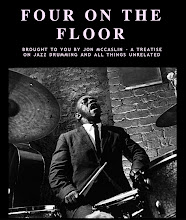
I've been getting many requests lately to feature more of my technique exercises (it's been awhile!) so here's some chop busters to chew on:
CLAVEDIDDLES
These exercises are based on a concept shown to me by percussionist and all around nice guy Russell Hartenberger (Professor at the University of Toronto and member of the percussion super group "Nexus")
When I studied with Russell during the fall of 1999 at the Banff Centre for the Arts during an extended residency, he gave me several sheets of snare drum exercises that were basically paradiddle patterns but which incorporated accent patterns derived from various traditional Ghanaian drum ensemble pieces (such as Gahu). I found these exercises to be very useful and a very practical and musical application of rudimental snare drum paradiddle patterns.
I've taken this idea a step further and used Russell's concept but using Afro-Cuban clave patterns instead.
I like to think of this being the sort of thing that Joe Morello would have come up with if he grew up playing with Los Munequitos De Matanzas or if Changuito had studied with George Lawrence Stone (!)
So here's the rundown...
Here is a one-bar clave accent pattern written over two bars of 8/4 time:

You can basically look at this pattern as being phrased in groupings of eighth-notes like this:
6 + 6 + 4 + 6 + 6 + 4 (the pattern is repeated)
Similarily, here's a 3-2 Son Clave written the same way:

Groupings: 6 + 6 + 8 + 4 + 8
And the reverse, 2-3 Son Clave:

Groupings: 4 + 4 + 8 + 6 + 6 + 4
And finally, written as a 3-2 Rumba Clave:

Groupings: 6 + 8 + 6 + 4 + 8
So practice all these patterns as single strokes RLRL, etc. and accenting each of these clave patterns. Make sure that the strokes are even and that you are properly playing the accents so the clave pattern is clear. This is important because the whole point of this exercise is PHRASING while using rudiments.
Once you've got that down, start to substitute different paradiddle sticking patterns for the groupings of single strokes, but still following the accent patterns.
Y'a dig ?
So going back to the first 3-2 Son Clave pattern:

I would make the following substitutions:
Groups of 4 = single paradiddle
Groups of 6 = double paradiddle
Groups of 8 = triple paradiddle
So keeping that mind, the 3-2 Son Clave pattern with those paradiddle stickings would look like this:
RLRLRR LRLRLL RLRLRLRR LRLL RLRLRLRR
LRLRLL RLRLRR LRLRLRLL RLRR LRLRLRLL
You could of course also incorporate paradiddlediddles (RLRLRR) for the groups six as well.
For example, here's the same accent pattern but using a different paradiddle/sticking combination:
RLRRLL RLRRLL RLRLRLRR LRLL RLRLRLRR
LRLLRR LRLLRR LRLRLRLL RLRR LRLRLRLL
Really the possibilities are endless and I'll leave it up to you to figure out any number of sticking variations using those accent patterns and different paradiddles. One could write a book of this stuff !
For further ideas of different clave patterns to use, check out Billy Martin's fine coordination book Riddim:

Lots of great clave-type patterns from all over the world are found in that book.
Don't forget that the whole point of this is to make MUSIC. These clave patterns are powerful rhythms and you'll find many interesting ways of playing them on the drum set with these expanded sticking combinations.
I'd like to thank Russell Hartenberger and Dafnis Prieto for their help and inspiration with these ideas.
Now grab your practice pad and hit the 'shed !




















No comments:
Post a Comment